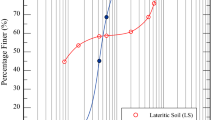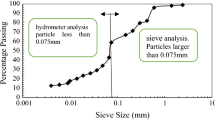Abstract
Rammed earth is used for load bearing walls of buildings and there is growing interest in this low carbon building material. This paper is focused on understanding the compaction characteristics and physical properties of compacted cement stabilised soil mixtures and cement stabilised rammed earth (CSRE). This experimental study addresses (a) influence of soil composition, cement content, time lag on compaction characteristics of stabilised soils and CSRE and (b) effect of moulding water content and density on compressive strength and water absorption of compacted cement stabilised soil mixes. Salient conclusions of the study are (a) compaction characteristics of soils are not affected by the addition of cement, (b) there is 50% fall in strength of CSRE for 10 h time lag, (c) compressive strength of compacted cement stabilised soil increases with increase in density irrespective of moulding moisture content and cement content, and (d) compressive strength increases with the increase in moulding water content and compaction of CSRE on the wet side of OMC is beneficial in terms of strength.














Similar content being viewed by others
References
Verma PL, Mehra SR (1950) Use of soil–cement in house construction in the Punjab. Indian Concr J 24:91–96
Easton D (1982) The rammed earth experience, 1st edn. Blue Mountain Press, Wilseyville
Easton D (2008) The industrialisation of monolithic earth walling for first world applications. In: Proceedings of the 5th international conference on building with earth (LEHM 2008), Koblanz, Germany. Dachverband Lehm e.V., Weimar, Germany, pp 90–97
Hall M (2002) Rammed earth: traditional methods, modern techniques, sustainable future. Build Eng 77(11):22–24
Houben H, Guillaud H (2003) Earth construction—a comprehensive guide. Intermediate Technology Publications, London
Walker P, Keable R, Martin J, Maniatidis V (2005) Rammed earth design and construction guidelines. BRE Bookshop, Watford
King B (1996) Buildings of earth and straw. Structural design for rammed earth and straw bale architecture. Ecological Design Press, Sausalito
Walker PJ (2002) Reinforced composite rammed earth in flexure. In: Proceedings of the international conference on non-conventional materials and technologies (NOCMAT/3), Vietnam, pp 439–445
Hall M, Damms P, Djerbib Y (2004) Stabilised rammed earth and the building regulations 2000. Part A. Structural stability. Build Eng 79(6):18–21
Hall MR (2007) Assessing the environmental performance of stabilised rammed earth walls using a climatic simulation chamber. Build Environ 42(1):139–145
Jayasinhe C, Kamaladasa N (2007) Compressive strength characteristics of cement stabilised rammed earth walls. Construct Build Mater 21:1971–1976
Prasanna Kumar P, Venkatarama Reddy BV (2007) Moisture content and compressive strength relationships for cement stabilised rammed earth walls. In: Proceedings of the international symposium on earthen structures. Interline Publishers, Bangalore, India, pp 224–230
Bui QB, Hans S, Morel JC (2007) The compressive strength and pseudo elastic modulus of rammed earth. In: Proceedings of the international symposium on earthen structures. Interline Publishers, Bangalore India, pp 217–223
Burroughs S (2008) Property criteria for rammed earth stabilisation. J Mater Civ Eng 20(3):264–273
Venkatarama Reddy BV, Prasanna Kumar P (2009) Compressive strength and elastic properties of stabilised rammed earth and masonry, Masonry International. J Int Masonry Soc 22(2):39–46. ISSN 0950-2289
Bulletin 5: Earth Wall Construction (1992) Commonwealth Scientific and Industrial Research Organisation (Division of Building Construction and Engineering), 4th edn. G.F. Middleton, Revised by L. M. Schneider, Australia
IS: 2110 (1998) Code of practice for in situ construction of walls in buildings with soil–cement. Bureau of Indian Standards, New Delhi, India
NZS: 4297 (1998) Engineering design of earth buildings. Standards New Zealand, New Zealand
NZS: 4298 (1998) Materials and workmanship for earth buildings. Standards New Zealand, New Zealand
NZS: 4299 (1998) Earth buildings not requiring specific design. Standards New Zealand, New Zealand
Lehmbau Regeln (2009) Dachverbandlehm, e.V., (Hrsg.), Begriffe-Baustoffe-Bauteile, and Auflage. PRAXIS, Germany
IS: 2720 (1980) Methods of test for soils. Part VII. Determination of water content-dry density relation using light compaction. Bureau of Indian Standards, New Delhi, India
IS: 8112 (1989) Indian standard specification for 43 grade ordinary Portland cement. Bureau of Indian Standards, New Delhi, India
IS: 4031 (1988) Methods of physical tests for hydraulic cement. Part 6. Determination of compressive strength of hydraulic cement other than masonry cement. Bureau of Indian Standards, New Delhi, India
Ingles OG, Metcalf JB (1977) Soil stabilization principles and practice. Butterworths Pty. Limited, Sydney
West G (1959) A laboratory investigation into the effects of elapsed time after mixing on the compaction and strength of soil–cement. Geotechnique 9(1):9–13
Venkatarama Reddy BV, Gupta A (2005) Characteristics of soil–cement blocks using highly sandy soils. Mater Struct (RILEM) 38(280):651–658
Venkatarama Reddy BV (2008) Retrofitting of damaged stabilised earth block buildings. In: Proceedings of the 5th international conference on building with earth (LEHM 2008), Koblanz, Germany. Dachverband Lehm e.V., Weimar, Germany, pp 105–111
Author information
Authors and Affiliations
Corresponding author
Rights and permissions
About this article
Cite this article
Venkatarama Reddy, B.V., Prasanna Kumar, P. Cement stabilised rammed earth. Part A: compaction characteristics and physical properties of compacted cement stabilised soils. Mater Struct 44, 681–693 (2011). https://doi.org/10.1617/s11527-010-9658-9
Received:
Accepted:
Published:
Issue Date:
DOI: https://doi.org/10.1617/s11527-010-9658-9




